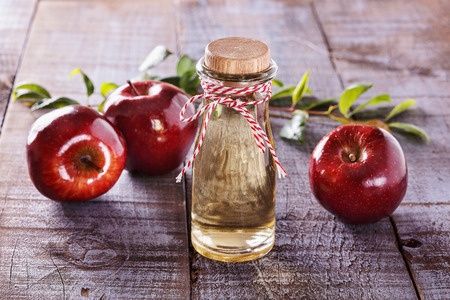
Vinegar is enjoyed all over the world, as a condiment or even as a beverage. It is especially popular in China, where it has enjoyed a long history and high reputation in that country. It is purely and simply a solution of acetic acid (ethanoic acid) along with a complex variety of flavours which often indicate the fruit source from which it originated.
Vinegar has been part of culinary life for thousands of years. In fact it is speculated that it was available at the dawn of civilisation, when humans were still following a nomadic existence. Then, natural yeast would have fermented fruit juices and the nourishment obtained might well have stimulated further interest in the liquid as a food.
Manufacture
Traditionally juice from fruit is poured over a mesh of birch twigs and grape or fig leaves which harbour natural yeasts. The juice is oxidised first to alcohol and then acetic acid. A variety of Acetobacter and yeasts are involved in the fermentation. The juice flows under gravity and by the time it leaves the fermenter has turned to vinegar.
The key phytochemicals are mainly organic acids, amino acids, and phenolic compounds.
Vinegar plays an important role in daily life due to its remarkable nutritional and therapeutic attributes. However it must be borne in mind that there is a lot of hype and mythology associated with the products. Even so there is a gathering source of clinical evidence bolstered by studies with animals which suggest it has some considerable benefits.
Nutrition
These relate to its:-
- antioxidant and antibacterial properties (Dávalos et al., 2005; Verzelloni et al., 2007; Sakanaka and Ishihara, 2008),
- reducing blood pressure (Honsho et al., 2005; Tanaka et al., 2009),
- reduction in triglyceride, cholesterol, and glycemic index (Leeman et al., 2005; Johnston and Gaas, 2006; Kondo et al., 2009),
- food appetizer and condiment (Darzi et al., 2010),
- anti-inflammatory activity (O’Keefe et al., 2008; Lee et al., 2011).
Chinese-style brewed vinegars, which contain more amino acids and organic acids than other kinds of vinegars, are traditionally brewed mainly from rice or sorghum fermentation seeding with Acetobacter and Gluconobacter (Uysal et al., 2013). The flavour is mainly generated from the grain fermentation process (Lin, 2005; Zho et al., 2008). Vinegar not only contributes to the flavour, but also improves the taste of food, especially the umami taste (Tachdjian et al., 2014).
References
Dávalos, A., Bartolomé, B., Gómez-Cordovés, C. (2005) Antioxidant properties of commercial grape juices and vinegars. Food Chem. 93 pp. 325–30
Honsho, S., Sugiyama, A., Takahara, A., Satoh, Y., Nakamura, Y., Hashimoto, K. (2005) A red wine vinegar beverage can inhibit the renin–angiotensin system: experimental evidence in vivo. Biol. Pharm. Bull. 28 pp. 1208–10
Johnston, C.S., Gaas, C.A. (2006) Vinegar: medicinal uses and antiglycemic effect. MedGenMed 8 pp. 61–61
Kondo, T., Kishi, M., Fushimi, T., Ugajin, S., Kaga, T. (2009) Vinegar intake reduces body weight, body fat mass, and serum triglyceride levels in obese Japanese subjects. Biosci. Biotechnol. Biochem. 73 pp. 1837–43.
Lee, C.S., Yi, E.H., Kim, H.R., Huh, S.R., Sung, S.H., Chung, M.H., Ye, S.K. (2011) Anti-dermatitis effects of oak wood vinegar on the DNCB-induced contact hypersensitivity via STAT3 suppression. J. Ethnopharmacol. 135 pp. 747–53
Leeman, M., Östman, E., Björck, I. (2005) Vinegar dressing and cold storage of potatoes lowers postprandial glycaemic and insulinaemic responses in healthy subjects. Eur. J. Clin. Nutr. 59 pp. 1266–71
Lin, Z.S. (2005) Multi-strain fermentation—the important way to improve the quality and flavor of soy sauce and vinegar. China Brewing 6 pp. 1–5
O’Keefe, J.H., Gheewala, N.M., O’Keefe, J.O. (2008) Dietary strategies for improving post-prandial glucose, lipids, inflammation, and cardiovascular health. J. Am. Coll. Cardiol. 51 pp. 249–55.
Sakanaka, S., Ishihara, Y. (2008) Comparison of antioxidant properties of persimmon vinegar and some other commercial vinegars in radical-scavenging assays and on lipid oxidation in tuna homogenates. Food Chem. 107 pp. 739–44
Tachdjian, C., Li, X., Qi, M., Rinnova, M., Servant, G., Zoller, M. (2014) Flavors, flavor modifiers, tastants, taste enhancers, umami or sweet tastants, and/or enhancers and use thereof. U.S. Patent 8895050.
Verzelloni, E., Tagliazucchi, D., Conte, A. (2007) Relationship between the antioxidant properties and the phenolic and flavonoid content in traditional balsamic vinegar. Food Chem. 105 pp. 564–71
Zho, C., Wang, P., Wang, S., Kang, L. (2008) Improvement of flavor and color of vinegar produced by submerged fermentation. China Brewing 19 pp. 59–61
Leave a Reply